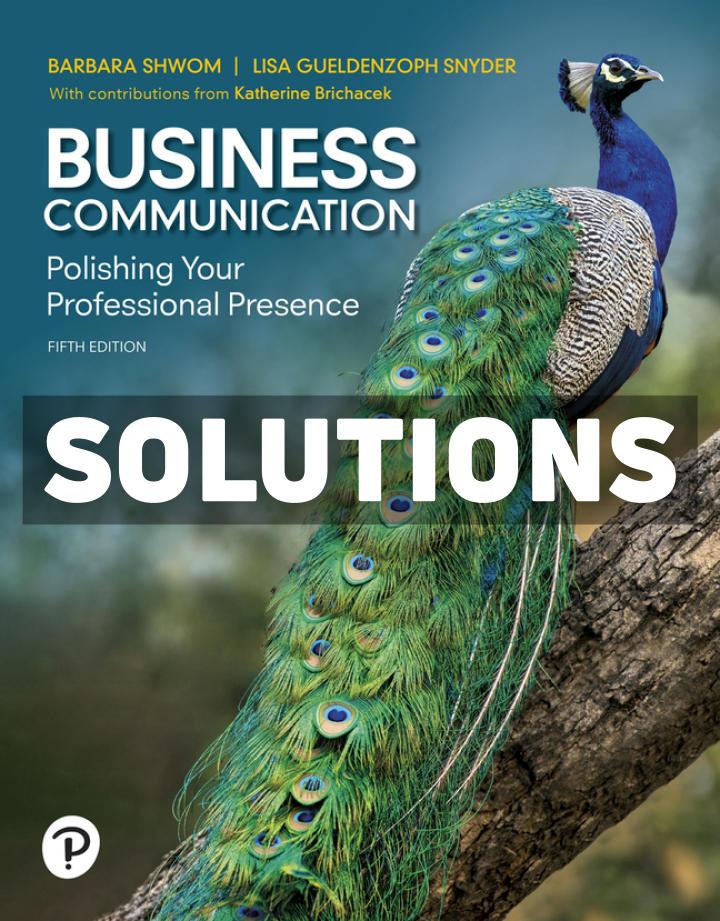

INSTRUCTOR’S MANUAL
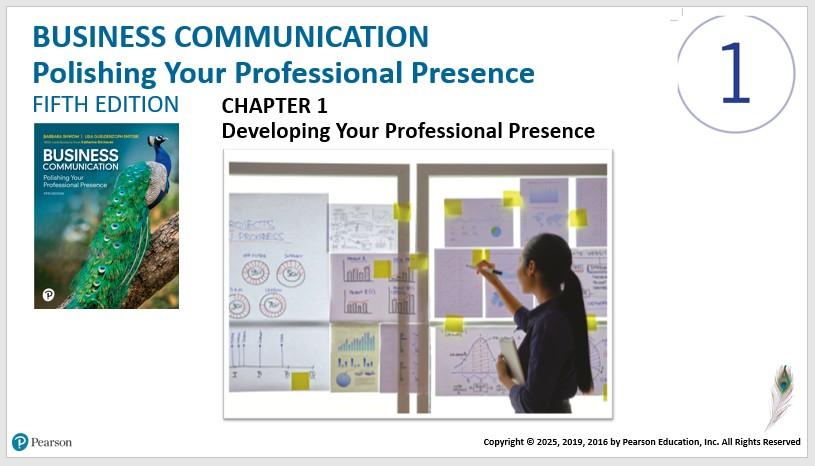
Learning Objectives
LO 1.1 Explain why communication is a complex process that is affected by context and requires more than the delivery of messages.
LO 1.2 Identify the benefits of being an effective communicator while on the job market and throughout your career.
LO 1.3 Explain why it is important for communicators to be strategic, professional, and adaptable.
LO 1.4 Explain how studying communication helps you develop other valuable career skills.
TEACHING TIP: This chapter serves as a foundation for the rest of the topics in the course and helps students understand why the information is important. If you want to introduce all the material in one week, you might spend your class time this way:
Class (or hour) 1: Communication is complex (LO 1.1) and benefits of effective communication (LO 2.2)
Class (or hour) 2: Communicators must be strategic, professional, and adaptable (LO 1.3)
Class (or hour) 3: Career skills (LO 1.4) and Case Study or in-class activities
AT-A-GLANCE HEADING OUTLINE
PROFESSIONAL PRESENCE @ Work, p. 3
SYNCHRONY, Ron Everett: Communication Is Never a Straight Line
Why is it challenging to communicate effectively? p. 4
LO 1.1 Explain why communication is a complex process that is affected by context and requires more than the delivery of messages.
Communication is a complex process, p. 5
Communication is affected by context, p. 5
Communication requires understanding yourself and others, p. 6
What are the benefits of being an effective communicator? p. 7
LO 1.2 Identify the benefits of being an effective communicator while on the job market and throughout your career.
Effective business communicators have a competitive edge in the job market, p. 7
Communication skills will contribute to your company’s success, p. 8
Communication skills will contribute to your personal success, p. 9
What characteristics will help you communicate effectively? p. 10
LO 1.3 Explain why it is important for communicators to be strategic, professional, and adaptable.
Being strategic, p. 10
Being professional, p. 14
SPOTLIGHT ON RESEARCH & THEORY PROFESSIONALISM, p. 19
Being adaptable, p. 21
What other important career skills will this course help you develop? p. 26
PROFESSIONAL PRESENCE @ Work, p. 27
SYNCHRONY, Ron Everett: Communication Is Never a Straight Line
CHAPTER REVIEW, p. 29
KEY TERMS, p. 30
REVIEW QUESTIONS, p. 30
KEY CONCEPT EXERCISES, p. 30
REFERENCES, p. 33
PROFESSIONAL PRESENCE @ Work, p. 3
SYNCHRONY, Ron Everett: Communication Is Never a Straight Line
TEACHING TIP: Each chapter in this book both starts and ends with a Professional Presence @ Work feature. Different professionals are used in each chapter, but the same person is highlighted in both the opening and ending features within a chapter.
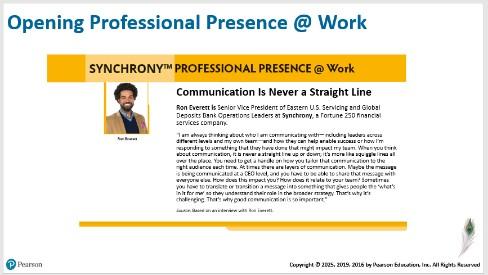
The opening @ Work features are short—they introduce the professional and their perspective on the topic of the chapter. The ending @ Work feature is longer and explains how the professional applies the content from the chapter to their work.
The goal of the @ Work feature is to illustrate how the content of the book is applicable in the workplace. The professionals we interviewed represent a wide array of positions and organizations, including senior-level corporate leaders, nonprofit directors, and researchers.
You can use the @ Work features as discussion starters (e.g., “What does Ron Everett mean when he says that communication is never a straight line?”) or small group activities (e.g., summarize the main takeaways of the opening and ending @ Work features in this chapter.

Chapter 1 | Introduction
Professional presence is the ability to project competence, credibility, and confidence. This chapter explains why communicating well is challenging, how you will benefit from becoming a better communicator, and what characteristics you should be able to demonstrate after completing this course to be a successful communicator.
CRITICAL THINKING QUESTION
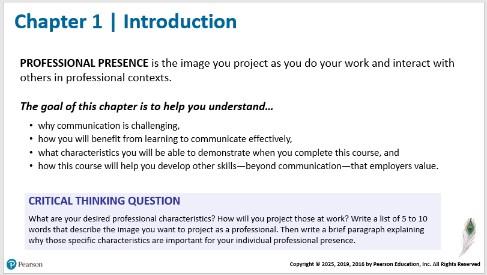
What are your desired professional characteristics? How will you project those at work? Write a list of 5 to 10 words that describe the image you want to project as a professional. Then write a brief paragraph explaining why those specific characteristics are important for your individual professional presence.
CRITICAL THINKING NOTE: Students’ answers will vary. This prompt could be used as a discussion starter, small group activity, or homework assignment.
Why is it challenging to communicate effectively? p. 4
LO 1.1 Explain why communication is a complex process that is affected by context and requires more than the delivery of messages.
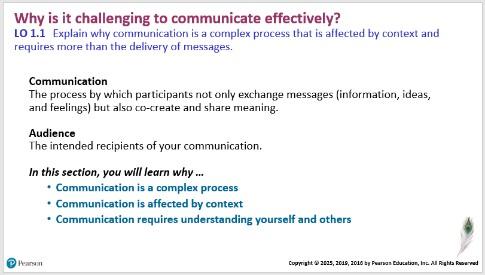
TEACHING TIP: To help students understand the complexity of communication, give them opportunities to reflect on their own successful and unsuccessful communication experiences.
Communication is more than the exchange of messages; it is the process by which participants not only exchange messages (information, ideas, and feelings) but also co-create and share meaning.
Success in communication is affected by a broad array of factors that go beyond the language you use, including the physical, social, and cultural context in which you communicate; your relationship with your audience; the audience’s knowledge and expectations; and your own self-awareness.
Audience is the intended recipients of your communication.
Communication is a complex process, p. 5
Communication experts have been developing models of the communication process for decades.
Models are useful visual tools that explain how a process works, especially when a process is complex and all its parts are not visible.
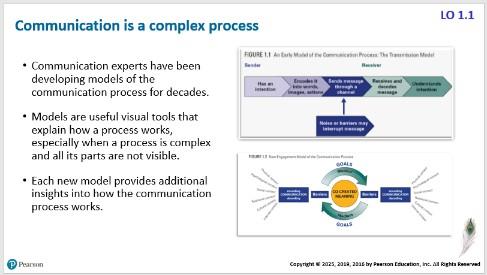
Each new model provides additional insights into how the communication process works.
See the Transmission Model of Communication in FIGURE 1.1 on p. 5
One of the first models developed to explain the communication process.
Focuses only on a single exchange of information from the sender to the receiver.
Does not take into account the many additional variables involved in effective communication.
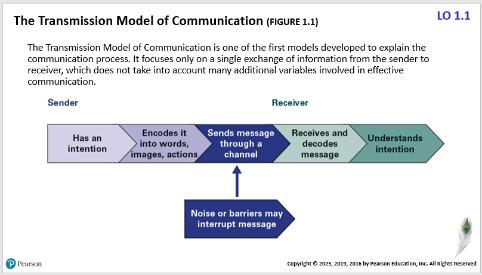

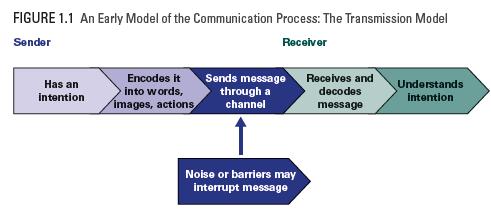
The Transmission Model introduced the key elements of communication:
o Medium: The method you use to deliver a message—for example, telephone, face-to-face meeting, email, text message, or website.
o Channel: The method you use to deliver a message, a synonym of medium.
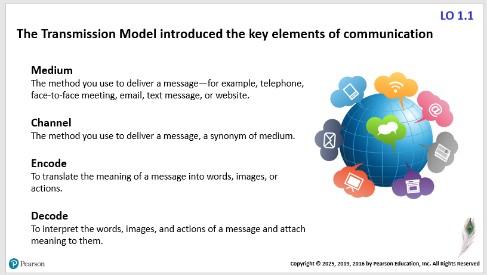
o Encode: To translate the meaning of a message into words, images, or actions.
o Decode: To interpret the words, images, and actions of a message and attach meaning to them.
Barriers are another element of communication. Barriers are obstacles that get in the way of effective communication and come in many forms:
Technological barriers may occur when your audience does not have access to the medium you are choosing.
Physiological barriers occur when something related to the physical functioning of a body becomes an obstacle.
Psychological barriers include unexamined biases and assumptions.
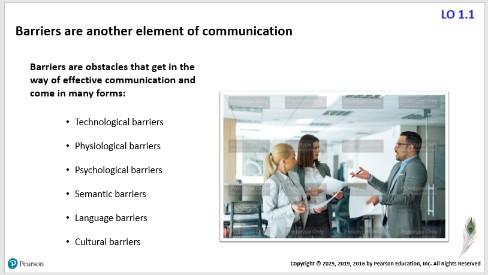
Semantic barriers occur when language is ambiguous or difficult to understand.
Language barriers arise when senders and receivers do not have a shared language.
Cultural barriers inhibit clear communication and can occur even when there is a shared language.
DISCUSSION STARTER: Which of these barriers have you experienced as a communicator? As a listener/reader? How did you overcome that barrier to reach your communication goal? Or how would you, now that you know more about the transactional model of communication?
TO PRACTICE THE CONTENT IN THIS SECTION, ASSIGN KEY CONCEPT EXERCISE:
1 Communication is a complex process, p. 30
IN-CLASS ACTIVITY: Have you ever been misunderstood?
Most people have experienced either being misunderstood or misunderstanding someone else. Ask students to provide examples, preferably from their work experiences or student interactions rather than personal relationships. Explore what went wrong, focusing attention particularly on encoding/decoding, medium, barriers, and feedback. If they were able to develop shared meaning through their communication, ask them to explain how. Throughout the discussion, help the students identify why the communication did not work well.
SUPPLEMENTAL EXERCISE: Analyzing a Miscommunication
Consider a time when you were unsuccessful at communicating something in the workplace. Consider all the possible barriers that may have interfered with the successful communication of your message. See p. 7 for a discussion of barriers. Write a brief blog posting (100–150 words) with an attention-grabbing headline (see “Writing Headlines That Get Results” for help with that, at http://www.copyblogger.com/writing-headlinesthat-get-results/) and post it to the class blog or discussion forum. Other students will be able to read your post, so be sure not to use real names of workplaces or people, and proofread carefully before you submit it. Read some of the other posts and respond to some of the students’ comments to which you can relate.
Communication is affected by context, p. 5
Despite its contributions to communication theory, the transmission model does not provide a full understanding of what happens when we communicate. For example, it does not take into account the iterative back-and-forth process that good communicators use to ensure understanding. Receivers become senders as they provide verbal and nonverbal feedback.
Feedback is any form of verbal or nonverbal response to a message.
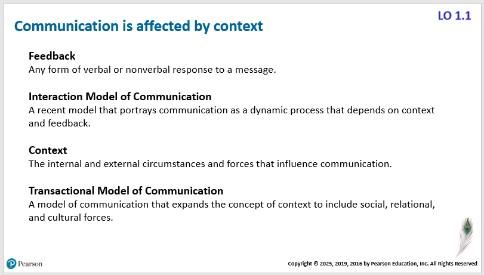
The Interaction Model of Communication portrays communication as a dynamic process that depends on context and feedback.
It also introduces the concept of context—the internal and external circumstances and forces that influence communication.
The Transactional Model of Communication expands the concept of context to address social, relational, and cultural factors:
o Social context includes how learned behaviors and norms influence communication choices.
o Relational context arises from past history and current relationships with your audience.
o Cultural context refers to the role that culture plays in influencing expectations about communication.
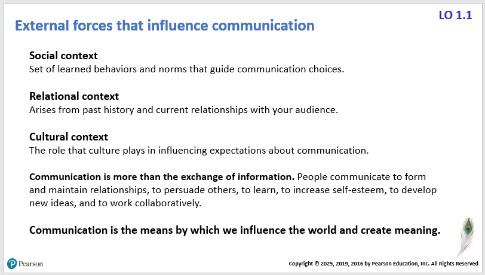
Communication is more than the exchange of information. People communicate to form and maintain relationships, to persuade others, to learn, to increase self-esteem, to develop new ideas, and to work collaboratively.
Communication is the means by which we influence the world and create meaning.
DISCUSSION STARTER: Provide an example of context and ask why it is important to consider in business communication.
TO PRACTICE THE CONTENT IN THIS SECTION, ASSIGN KEY CONCEPT EXERCISE:
2 Communication is affected by context, p. 30
Communication requires understanding yourself and others, p. 6
The Engagement Model of Communication (see FIGURE 1.2 on p. 6) builds on past models and extends them. This new model takes into account the role that internal contexts—preferences, biases, and learned behaviors—play in effective communication.
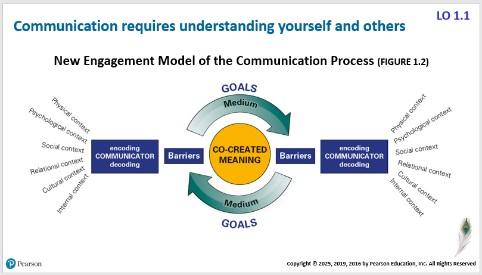
Successful communicators are not passively influenced by contexts and barriers. Instead, they engage in self-awareness, that is, awareness of their own internal contexts—their preferences, biases, and learned behaviors.
The new model also acknowledges that meaning is not just shared but is in fact co-created as everyone involved in the communication learns from each other. In a business communication course, you will learn to engage with all these complexities as you make and implement your communication decisions.

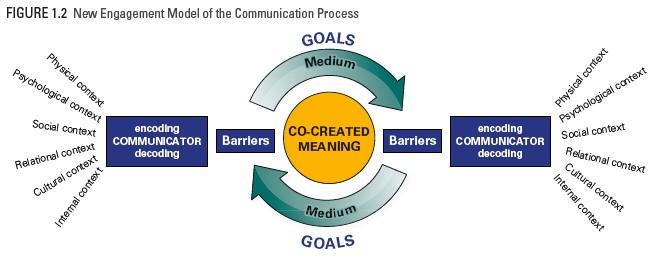
DISCUSSION STARTER: Review Figure 1.2. When you consider how barriers and context add complexity to communication, can one ever achieve perfect shared meaning? Why or why not? TO PRACTICE THE CONTENT IN THIS SECTION, ASSIGN KEY CONCEPT EXERCISE: 3 Communication requires understanding yourself and others, p. 30
What are the benefits of being an effective communicator? p. 7
LO 1.2 Identify the benefits of being an effective communicator while on the job market and throughout your career.
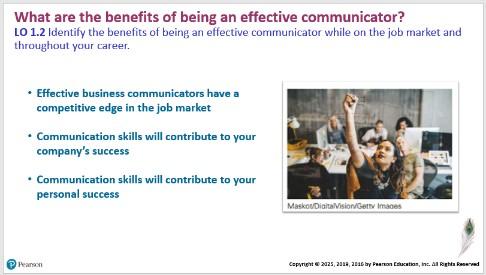
TEACHING TIP: One way to motivate students to care about business communication is to show them how they will benefit from being good communicators. To supplement the book and your own anecdotes, invite a guest speaker—a human resources professional, a job recruiter, or a manager—to come to class and talk about communication in the hiring process and in the workplace.
Effective business communicators have a competitive edge in the job market, p. 7
Despite predictions that technology—especially artificial intelligence—will make many professional jobs obsolete, research shows that certain job categories have experienced significant growth over the past several decades.
Surveys and interviews of corporate recruiters make it very clear that employers want to hire good communicators. Employers rated the following competencies as the most important for students to develop and carry into their careers:
o Critical thinking
o Teamwork
o Communication
o Equity and inclusion
o Professionalism
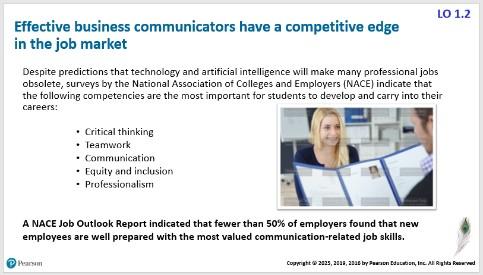
A NACE Job Outlook Report indicated that fewer than 50% of employers found that new employees are well prepared with the most valued communication-related job skills.
Importantly, employers rated the first three of these competencies as more important than technological competence and even leadership. Even more importantly, all these competencies are integrated within the study of business communication.
Communication also tops the list of the essential workplace skills identified by MBA alumni and recruiters surveyed by the Graduate Management Admission Council.
Ironically, although these communication skills are widely considered important, many employers report that they have difficulty finding applicants with adequate soft skills, including communication.
FIGURE 1.3 How Students’ Perceptions of Student Preparedness Differ from Employers’ Perceptions, p. 8
Research suggests that young workers do not sufficiently prepare themselves before entering the workforce because they do not recognize their deficits in these areas.
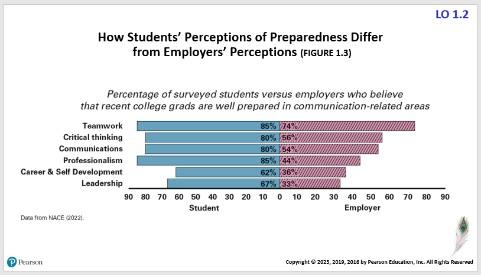
The NACE study found a large gap between college students’ perceptions of their proficiency and employers’ perceptions in many of the skills that employers find most important.
Being an effective communicator will help you stand out in the workplace.

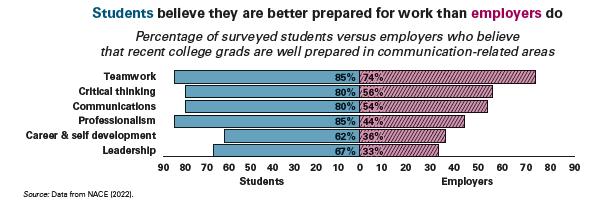
DISCUSSION STARTER: How well prepared for work do you think you are? Which of the skills listed in Figure 1.3 do you feel most or least confident about applying in the workplace?
DISCUSSION STARTER: The data show that effective communicators have a competitive edge when looking for jobs. Why do you think communication is so important?
TO PRACTICE THE CONTENT IN THIS SECTION, ASSIGN KEY CONCEPT EXERCISE: 4 Effective business communicators have a competitive edge in the job market, p. 30
SUPPLEMENTAL EXERCISE: What Your Future Holds
What occupation do you plan to pursue upon graduation? Using both the Occupational Outlook Handbook (http://www.bls.gov/oco/) and O*NET (http://www.onetcenter.org/overview.html), do a search for the occupation. According to the information you find on either of these websites, what communication skills will you need? Write a brief email (100–150 words) to your instructor about the occupation you researched and the communication skills you will need. Proofread your email carefully.
Communication skills will contribute to your company’s success, p. 8
Companies want good communicators because good communication is profitable it saves money, and it makes money. Consider the following ways in which better communication skills can increase your value to a company:

Writing. Clear, effective writing can save organizations hundreds of thousands of dollars, while ineffective communication can cost time and money.
Listening and speaking confidently. Productivity increases when you effectively listen to customers’ needs, answer questions efficiently, communicate solutions to problems, and collaborate well with team members.
Developing a communication strategy. Companies that are highly effective at communicating also experience greater employee satisfaction, greater productivity, and greater investor confidence.
Implementing social media. Social media includes web-based applications that are designed to promote social interaction. Examples include LinkedIn, Facebook, YouTube, TikTok, X (formerly Twitter), and Instagram.
CRITICAL THINKING QUESTION
Businesses use different social media tools for different purposes. Based on your knowledge of Facebook, LinkedIn, YouTube, Instagram, and TikTok, how do you expect businesses would use each of these tools?
CRITICAL THINKING NOTE: Students’ answers will vary. Sample responses could indicate that businesses use Facebook and/or Instagram to engage customers and build brand awareness, LinkedIn to recruit employees, YouTube to provide training and education, and TikTok to provide product/service demonstrations and content-based marketing by influencers.
DISCUSSION STARTER: How do good/effective communication skills contribute to being a “great” employee?
DISCUSSION STARTER: In jobs that require exceptional math skills, such as actuarial science, accounting, finance, and business information systems, why do employers still demand strong communication skills?
TO PRACTICE THE CONTENT IN THIS SECTION, ASSIGN KEY CONCEPT EXERCISE: 5 Communication skills will contribute to your company’s success, p. 30
Communication skills will contribute to your personal success, p. 9
TEACHING TIP: All students have some strengths as communicators. You can begin this section by asking students to do a self-assessment. Where do they believe they are strong? Where are they weak? What is the evidence to support their self-assessments?
Communication skills may improve your salary, p. 9
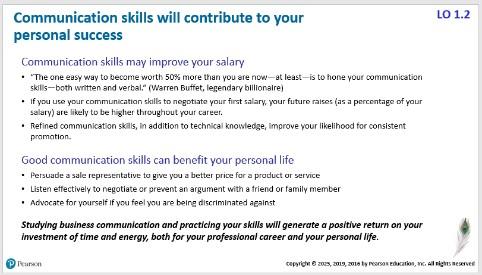
“The one easy way to become worth 50% more than you are now—at least—is to hone your communication skills—both written and verbal.” (Warren Buffett, legendary billionaire)
If you use your communication skills to negotiate your first salary, your future raises (as a percentage of your salary) are likely to be higher throughout your career.
Refined communication skills, in addition to technical knowledge, improve your likelihood of consistent promotion.
Good communication skills can benefit your personal life, p. 9
Persuade a sales representative to give you a better price for a product or service.
Listen effectively to negotiate or prevent an argument with a friend or family member.
Advocate for yourself if you feel you are being discriminated against.
Studying business communication and practicing your skills will generate a positive return on your investment of time and energy, both for your professional career and your personal life.
TO PRACTICE THE CONTENT IN THIS SECTION, ASSIGN KEY CONCEPT EXERCISE:
6 Communication skills will contribute to your own success, p. 31
What characteristics will help you communicate effectively? p. 10
LO 1.3 Explain why it is important for communicators to be strategic, professional, and adaptable.

As you continue to polish your professional presence, consider your current skills and abilities. Think about your core abilities: writing, speaking, listening, and interpersonal communication. The best business communicators—those who have real presence, are able to connect with other people, and successfully deal with communication challenges—share the specific characteristics illustrated in FIGURE 1.4 on p. 10.

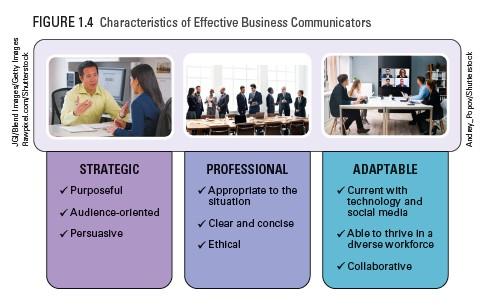
Being strategic, p. 10
The best communicators have a communication strategy a plan for what and how to communicate to ensure that their message achieves its purpose, which is the reason they are communicating.
Strategic communicators are always making decisions, asking themselves these questions:

What do I want to accomplish with this communication? What is my goal?
Who is my audience? With whom should I communicate to accomplish my goal?
What content will my audience need?
What medium will work best—a face-to-face meeting, an online meeting, an email, a presentation, a report, or a combination of medium options?
How can I frame and organize the message to state the main point and effectively support it?
Purposeful, p. 10
Business communication involves more than self-expression. It needs to be purposeful and constructed to achieve an intended outcome.
Outcome—the result of your communication; what you want the recipients of your message to know, do, or feel about the subject of your message.
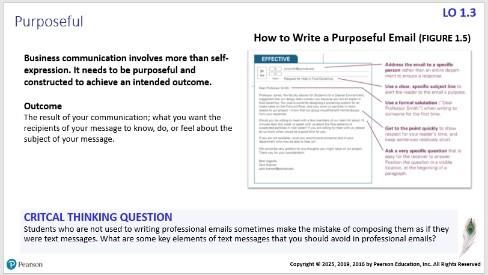
See FIGURE 1.5 on p. 11 for an example of how to write a purposeful email:
Address a specific person.
Use a clear, specific subject line.
Use a formal salutation.
Get to the point quickly.
Ask a very specific question.

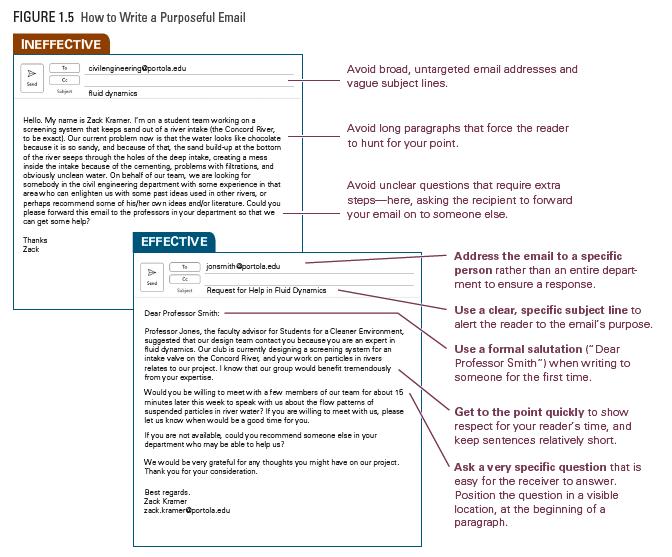
CRITICAL THINKING QUESTION
Students who are not used to writing professional emails sometimes make the mistake of composing them as if they were text messages. What are some key elements of text messages that you should avoid in professional emails?
CRITICAL THINKING NOTE: Possible answers include misspellings, incorrect punctuation, emoticons, unstructured sentences and ideas, and improper greetings and closings.
TO PRACTICE THE CONTENT IN THIS SECTION, ASSIGN KEY CONCEPT EXERCISE:
7 Being strategic Purposeful, p. 31
Audience-Oriented, p. 11
Good business communicators understand that their messages must reach and influence their audience, which requires two complementary skills:
1. Being a good reader and listener
2. Composing messages that are easy to understand

Active Listening—a learned skill that requires you to attentively focus on the speaker’s communication, interpret the meaning of the content, and respond with feedback to ensure understanding.
Unconscious Bias (also called Implicit Bias)—beliefs and attitudes that are outside of our conscious awareness and control, often based on stereotypes and prejudices.
Think about meeting audience needs in two ways:
1. Make the message easy for your audience to understand to increase the chances that people will accurately read or listen to your message.
2. Provide the content that the audience needs or wants. If you anticipate possible objections, you will increase the chances that you will get the response you want.
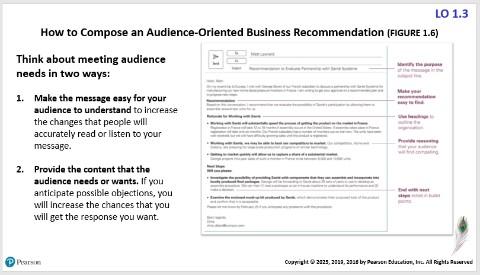
See FIGURE 1.6 on p. 13 for an example of how to compose an audience-oriented business recommendation:
Identify the purpose.
Make your recommendation easy to find.
Use headings, if applicable.
Provide reasoning.
End with next steps.
CRITICAL THINKING QUESTION
Although it is important to consider your audience’s potential questions and objections when you communicate, you may not always know a lot about the people in your audience in advance. Imagine, for example, that you are sending a business proposal to a new client you have never met before. How can you learn more about your audience before writing the proposal?
CRITICAL THINKING NOTE: Possible answers: (1) talking to your audience in advance, in a telephone or face-toface meeting, if possible; (2) talking to people who know your audience; (3) talking to people similar to your audience; and (4) imagining your audience and brainstorming their possible reactions.
TO PRACTICE THE CONTENT IN THIS SECTION, ASSIGN KEY CONCEPT EXERCISE: 8 Being strategic—Audience-oriented, p. 31

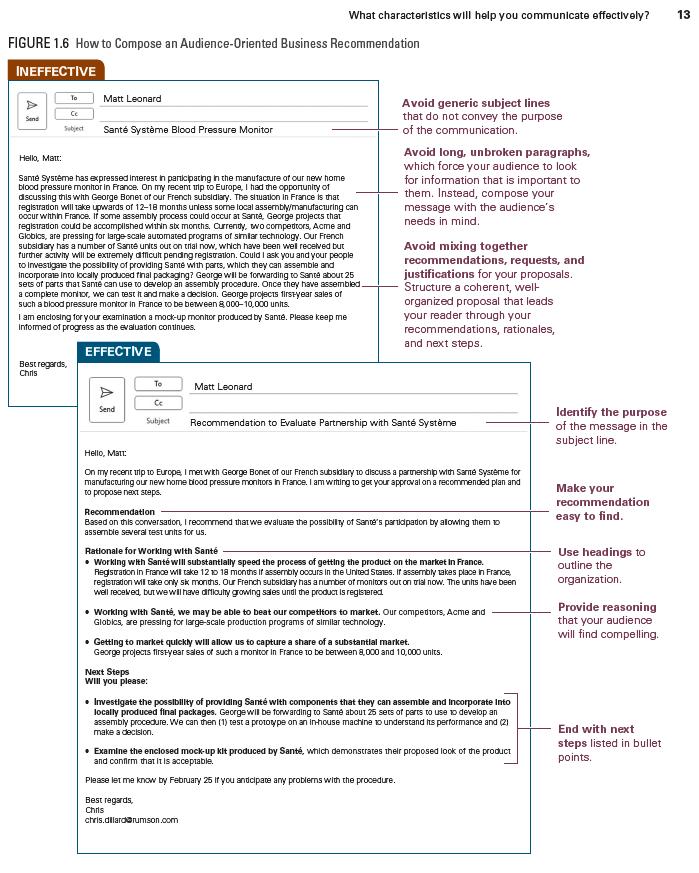
Persuasive, p. 14
When you want to influence people’s thoughts or actions, your message needs to be persuasive.
Persuasion is the process of influencing an audience to agree with your point of view, accept your recommendation, grant your request, or change their beliefs or actions in a way that facilitates a desired outcome.
Being persuasive requires you to think about the topic from your audience’s point of view:
What benefits do you offer?
What audience objections do you need to address?
What reasons and factual evidence support your claim?
See FIGURE 1.7 on p. 15 for an example of how to compose a persuasive letter:
Begin with a clear purpose.
Focus on benefits.
Respond to objections.
Anticipate and respond to potential objections.
Use the closing to emphasize next steps.
CRITICAL THINKING QUESTION
Imagine that you are trying to persuade a teammate to agree with an idea for a presentation, and the teammate accuses you of being manipulative—trying to influence someone for your own advantage. What is the difference between being persuasive and being manipulative?
CRITICAL THINKING NOTE: Persuasion looks at something from your audience’s point of view and outlines the benefits to the audience with clear supporting reasons and evidence, while manipulation serves only one person—you. For example, manipulation includes making people do something that they don't want to do, making people believe a lie so they will do things your way, and making people feel inadequate unless they agree with you.
TO PRACTICE THE CONTENT IN THIS SECTION, ASSIGN KEY CONCEPT EXERCISE:
9 Being strategic—Purposeful, p. 31

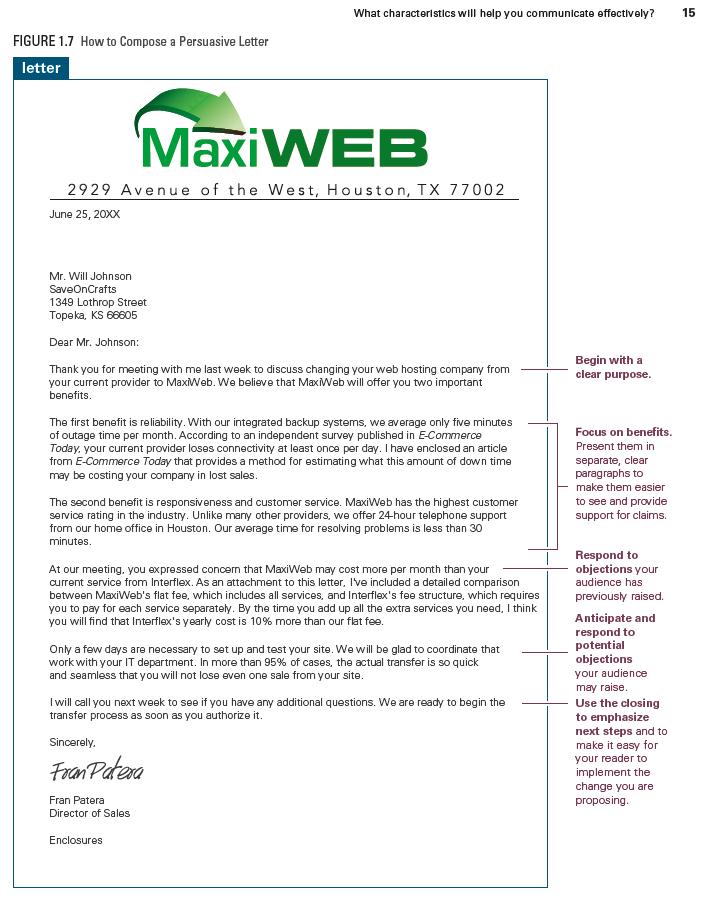
DISCUSSION STARTER: Consider communication with friends, family, co-workers, supervisors, and/or teachers. Do you use different approaches with each group? Provide an example of a time when you communicated strategically with a specific audience.
Being
professional, p. 14
The 2022 survey conducted by the National Association of Colleges and Employers identified professionalism as one of the characteristics most important in a new hire. Professionalism generally refers to the qualities that make you appear businesslike and allow you to be effective within the culture of your workplace.

Communicate effectively and appropriately, and always finding a way to be productive. Employers want new workers to be responsible, ethical, and team-oriented, and to possess strong communication, interpersonal, and problem-solving skills. Wrap these all together, and you’ve got professionalism. (U.S. Department of Labor)
Three characteristics contribute to professionalism:
1. Being appropriate to the situation
2. Being clear and concise
3. Being ethical
DISCUSSION STARTER: A person’s professionalism is often judged based on whether a document is spellchecked and free of grammatical errors. Do you believe this is a fair basis for making a judgment?
NOTE: Minor errors may indicate a person is not careful, is not concerned with the professionalism of their work, and is not resourceful enough to find a way to get the errors corrected.
Appropriate to the situation, p. 14
Different situations require different behaviors.
Business etiquette is an agreed-upon set of rules for communication that reflect respect for others and help create a healthy work environment.
Professionalism is as important in writing as it is in speaking:
• Be professional in your work messages without being overly formal.

• FIGURE 1.8 (p. 16) is unprofessional, whereas FIGURE 1.9 (p. 16) is appropriate for work.

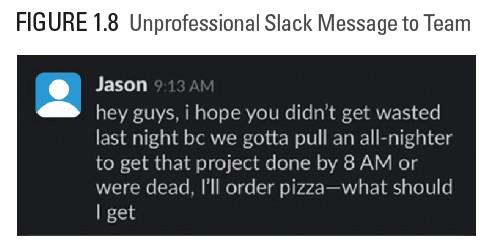

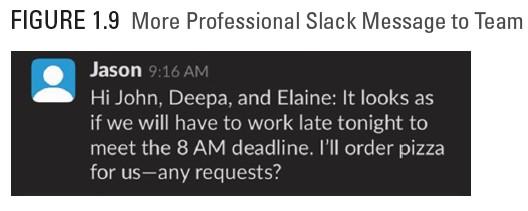
See FIGURE 1.10 on p.17 for an example of how to convey professionalism in an email:
Address emails to specific recipients.
Use headings and paragraphs.
Use bullets, if applicable.
End with a complimentary closing.
Sign all emails with a signature block.

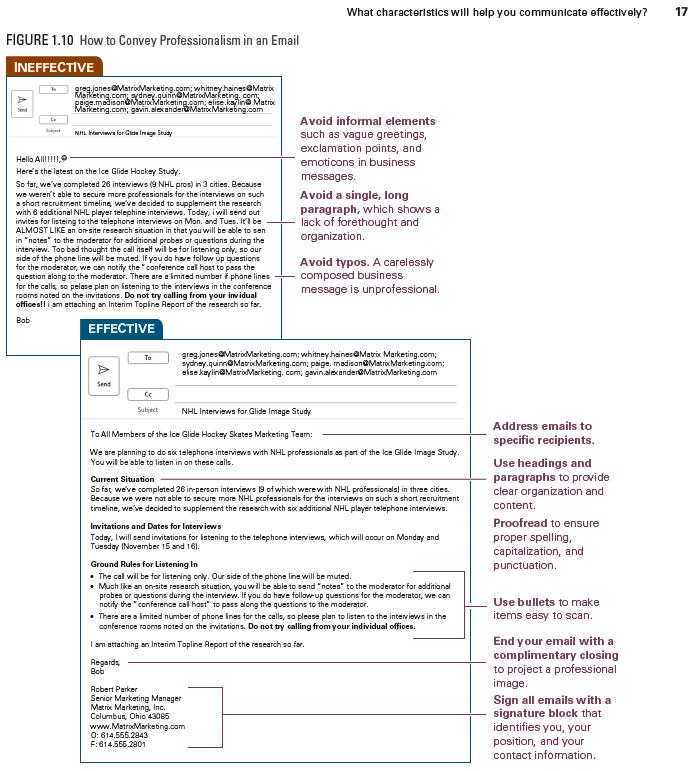
CRITICAL THINKING QUESTION
Some people argue that using emojis in business emails is unprofessional. Others say that emojis are useful because they help the audience interpret the writer’s intention more effectively. Would you choose to use emojis in your business email? Explain why or why not. Provide evidence or reasoning to support your decision.
CRITICAL THINKING NOTE: Students’ answers will vary based on their personal experiences. Emoticons are generally not suitable in business emails, especially more formal ones. However, they may be acceptable when communicating with close friends or peers. Emoticons are best avoided when the writer does not know the audience well enough to depend on a positive response.
Clear and concise, p. 16
In business, people value clarity and conciseness in both written and spoken communication.
Clarity is the quality of being unambiguous and easy to understand.
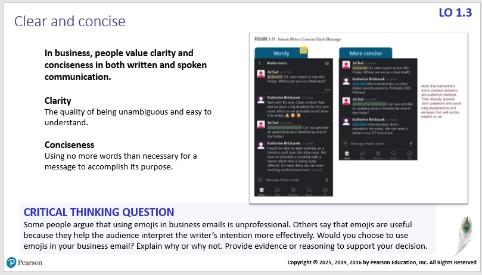
Conciseness means using no more words than necessary for a message to accomplish its purpose.
See FIGURE 1.11 on p. 18 for an example of revising wordy Slack messages to make them more concise.

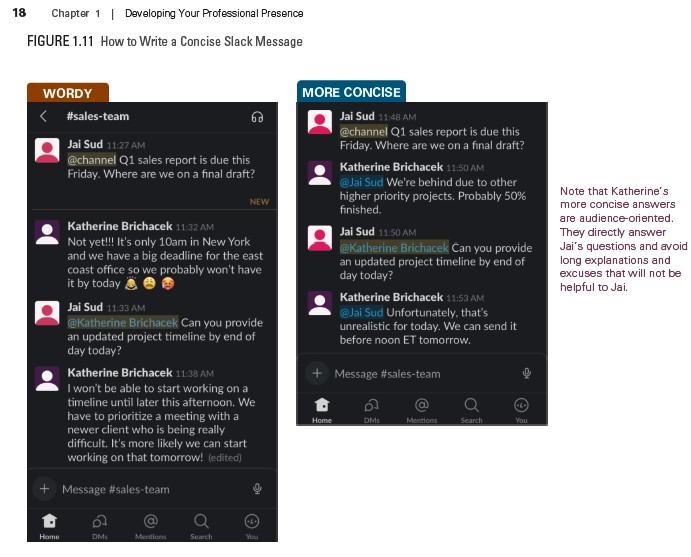
How to Compose a Message That is Clear and Concise
(FIGURE 1.12, p. 18)
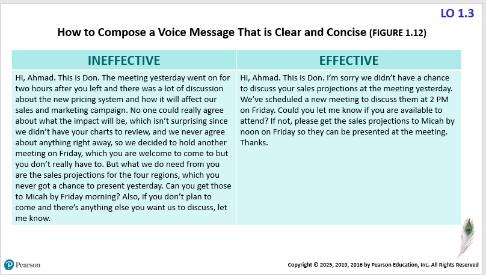

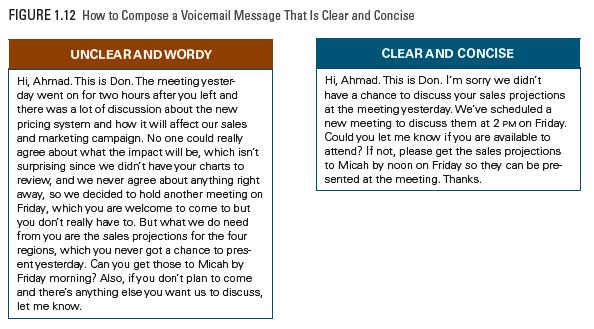
IN-CLASS ACTIVITY: Display a poorly written email, perhaps from a former student (removing the identity), that demonstrates poor format, spelling, or grammar. Discuss the nonverbal message the email communicates. If you like, ask students to rewrite the email message.
DISCUSSION STARTER: How might someone communicate unethically during a job search? What are the risks of this unethical behavior?
TO PRACTICE THE CONTENT IN THIS SECTION, ASSIGN KEY CONCEPT EXERCISE: 11 Being Professional—Clear and concise, p. 32
SPOTLIGHT ON RESEARCH & THEORY, p. 19
The term “professionalism” has a history of harmful connotations and covert meanings. Studies have explored how calls to appear and speak more professionally can marginalize employees based on race, religion, gender identity and expression, sexual orientation, and disability.
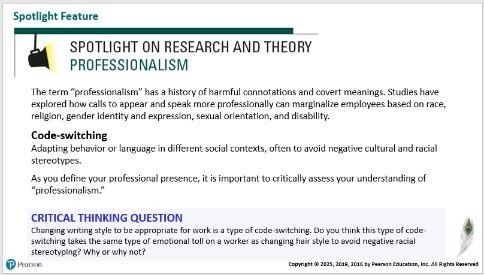
Code-switching is adapting behavior or language in different social contexts, often to avoid negative cultural and racial stereotypes.
As you define your professional presence, it is important to critically assess your understanding of “professionalism.”


CRITICAL THINKING QUESTION
Changing writing style to be appropriate for work is a type of code-switching. Do you think this type of codeswitching takes the same type of emotional toll on a worker as changing hair style to avoid negative racial stereotyping? Why or why not?
CRITICAL THINKING NOTE: Students’ answers will vary based on their personal experiences.
Ethical, p. 19
As a professional, you are likely to face a number of ethical dilemmas that are difficult to resolve—and as the survey by the American Association of Colleges and Universities (AAC&U) indicates, employers believe that recent graduates are not well prepared to resolve them.

Ethical dilemmas are situations in which there is a conflict between two sets of values and there is no one clear answer.
Ethics are the principles you use to guide decision making, leading you to do the right thing. However, the right thing is not always immediately obvious, and making a decision that violates ethical standards may pose a risk to your career, your colleagues, your customers, or your company. Being ethical means telling the truth, taking responsibility for your actions, and imagining the impact of your actions on others.
Being ethical means …
Telling the truth.
Taking responsibility for your actions.
Imagining the impact of your actions on others.
CRITICAL THINKING QUESTION
Many companies publish well-considered codes of behavior and ethics to guide employees and to reassure investors. One such company in the fashion industry is Lululemon, which publishes both a Global Code of Business Conduct and Ethics and a vendor code of ethics to communicate the ethical requirements for its suppliers. Despite these statements, some critics argue that Lululemon is not ethical enough. Read Lululemon’s published codes and the criticisms. What is your assessment of the company’s ethics? If you were working for this company, would you have concerns about its business conduct and ethics, or would you be proud of it?
CRITICAL THINKING NOTE: Students’ answers will vary based on their perceptions of Lululemon’s published codes and the criticisms. To use this prompt as an in-class activity or discussion forum, assign the question ahead of time to give students a few days to find the content, study the information, and reflect on whether they would have concerns or be proud of Lululemon’s business conduct and ethics.
DISCUSSION STARTER: Assume that your supervisor asked you to lie to a customer in an email about why a shipment is delayed. Would it be unethical for you to write the email if you believe it is wrong to lie? Conversely, would it be unethical for you to refuse to write the email if you believe you have a responsibility to your employer? How would you resolve this issue?
NOTE: In general, it is unethical to lie. To resolve the situation, discuss your options with your supervisor to find a mutually acceptable version of the truth. For example, you may choose not to explain that the shipment is late because you forgot to submit the order. Instead, you could truthfully provide a revised delivery date and a sincere apology.
TO PRACTICE THE CONTENT IN THIS SECTION, ASSIGN KEY CONCEPT EXERCISE: 12 Being professional—Ethical, p. 32
Being adaptable, p. 21
The business world evolves continually, requiring you to adapt both as an employee and as a communicator.
It is impossible to predict how business will change in the future and how communication will change as a result. Only one thing is certain more change will come, and as a business communicator, you must learn to adapt to …
new technologies,
colleagues and customers from varied backgrounds, and
new ways of working with others.
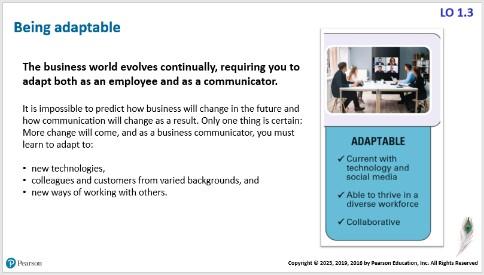
DISCUSSION STARTER: Explain how and why being professional and adaptable contribute to a communicator’s ability to be purposeful, audience-oriented, and persuasive. [Note: Students should use the characteristics in this section to support their response.]
Current with technology and social media, p. 22
Technology changes quickly. Being an effective business communicator requires that you learn and take advantage of new communication technologies as they arise. To take the best advantage of technology, communicators continually need to address three questions:
1. What is the most suitable technology for the task?

2. How can I avoid the technology traps that hinder effective communication?
3. How can I adapt new technology to business use?
Choose the best technology for the task. Often, no choice is perfect, so you will need to make thoughtful decisions.
Avoid technology traps. As a good communicator, you don’t need to be an expert at all technologies, but you do need to think about the implications of your technology choices and use your options wisely.
Adapt familiar technology to business use. Businesses must use social media differently than individuals do because businesses have distinct outreach and communication goals, such as …
reaching customers,
providing customer support and education,
finding new employees through social recruiting, and
engaging existing employees and improving productivity.
Augmented reality is an interactive technology that combines the real world and computer-generated content.
Brand ambassadors are people authorized by a company to bring positive attention to a brand on social media, helping increase brand awareness and sales.
Goodwill is the positive relationship between you (or your company) and the audience.
DISCUSSION STARTER: Technological developments provide many ways to send and receive messages. Have these tools made the communicator’s job easier or more difficult?
Able to thrive in a diverse workforce, p. 24
Workplaces are becoming increasingly diverse, bringing together people from different generations, countries, cultures, backgrounds, and abilities. Although these differences create a collective wealth of knowledge and breadth of perspectives, they also can make communication challenging. Bridging these differences requires selfawareness, respect, and patience.
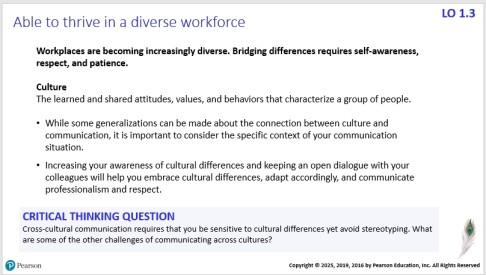
Culture is the learned and shared attitudes, values, and behaviors that characterize a group of people.
While some generalizations can be made about the connection between culture and communication, it is important to consider the specific context of your communication situation.
Increasing your awareness of cultural differences and keeping an open dialogue with your colleagues will help you embrace cultural differences, adapt accordingly, and communicate professionalism and respect.
CRITICAL THINKING QUESTION
Cross-cultural communication requires you to use clear language. What are some of the other challenges of communicating across cultures?
CRITICAL THINKING NOTE: Students’ answers will vary; possible answers include (1) not understanding others’ language, (2) accidentally showing disrespect or disregard, (3) addressing others with inappropriate levels of informality, and (4) misinterpreting nonverbal communication or inadvertently communicating something nonverbally.
TO PRACTICE THE CONTENT IN THIS SECTION, ASSIGN KEY CONCEPT EXERCISE: 16 Being adaptable—Able to thrive in a diverse workplace, p. 32
Collaborative, p. 25
Collaboration is the process of working with others to achieve a common goal. In business, although you will routinely communicate as an individual, many of your projects will be team-based because they are too big to be completed by just one person, making collaboration crucial in the workplace.
Being collaborative requires you to:
Adapt to the working styles of many different people
Coordinate work among team members
Determine how and when to share information with each other
Evaluate options and, when needed, compromise
Manage conflicts
Negotiate agreements
CRITICAL THINKING QUESTION

Imagine that you have been asked to collaborate on a project with a colleague whose work style is very different from yours. For example, you like to plan carefully and follow a schedule, whereas your colleague is spontaneous. You like to write thorough drafts that require only minimal revision, whereas your colleague likes to write incomplete drafts and revise heavily later. Based on these differences, you think it would be more efficient and cost-effective for the company to have you work on this project by yourself. Should you make that argument to your supervisor? What might be the benefits of collaborating? What are the drawbacks?
CRITICAL THINKING NOTE: Benefits of collaboration include (1) multiple points of view and talents that may lead to an improved final product and (2) division of labor that allows for sharper focus on specific areas. Drawbacks include time-consuming conflict management and negotiation. Typically, the benefits of collaboration outweigh the drawbacks.
DISCUSSION STARTER: How is workplace collaboration (or teamwork) similar to or different from teamwork in school?
DISCUSSION STARTER: Imagine you have been asked to collaborate on a project with a colleague whose work style is very different from yours. For example, you like to plan carefully and follow a schedule, whereas your colleague is spontaneous. You like to write thorough drafts that require only minimal revision, while your colleague likes to write incomplete drafts and revise heavily later. Based on these differences, you think it would be more efficient and cost-effective for the company to have you work on this project by yourself. Should you make that argument to your supervisor? What might be the benefits of collaborating? What are the drawbacks?
NOTE: Benefits of collaboration include (1) multiple points of view and talents that may lead to an improved final product and (2) division of labor that allows for sharper focus on specific areas. Drawbacks include timeconsuming conflict management and negotiation. Typically, the benefits of collaboration outweigh the drawbacks.
TO PRACTICE THE CONTENT IN THIS SECTION, ASSIGN KEY CONCEPT EXERCISE: 15 Being adaptable—Collaborative, p. 32
What other important career skills will this course help you develop? p. 26
LO 1.4 Explain how studying communication helps you develop other valuable career skills.
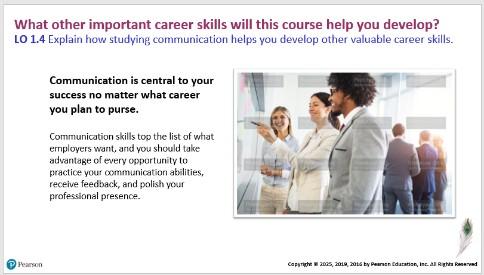
TEACHING TIP: Students may not immediately understand how skills such as ethical reasoning or collaboration are connected to communication. Ask students to share their understanding of how the skills on the list are related to each other, to communication, and to business success.
Communication is central to your success no matter what career you plan to pursue. Communication skills top the list of what employers want, and you should take advantage of every opportunity to practice your communication abilities, receive feedback, and polish your professional presence.
FIGURE 1.13 How This Course Will Help You Develop Important Employability Skills (p. 26)
Critical thinking—a disciplined approach to analyzing, synthesizing, and evaluating information to guide actions and decisions.
Collaboration—the ability to work with others to achieve a common goal.
Ethical reasoning—using a set of principles to guide thinking and lead a person to do the right thing.
Ability to apply knowledge in new situations—the ability to learn a concept and then appropriately apply that knowledge in another setting.
Ability to use technology effectively—the ability to select and use appropriate technology to accomplish a given task.
Data literacy—the ability to access, assess, interpret, manipulate, summarize, and communicate data.
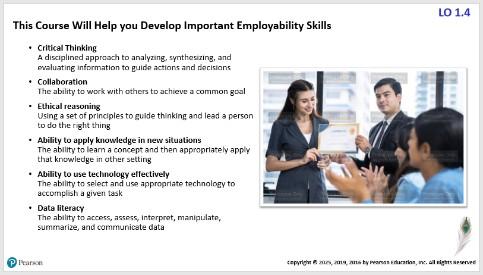

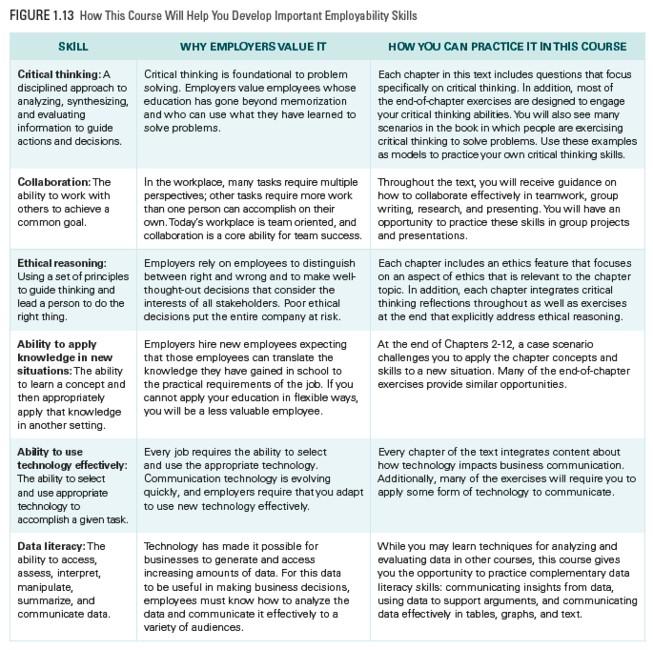
DISCUSSION STARTER: How well has your classroom education prepared you for workplace challenges so far? What insights have you gained from your work experience, and what do they contribute to your understanding of classroom topics? Give examples from your own experience of the connections—and tensions—between school and work.
IN-CLASS ACTIVITY: In small groups, have each student select a reason why employers value a particular skill from Figure 1.13 and explain to their group why they agree or disagree with the reason given, providing an example from their own experience.
TO PRACTICE THE CONTENT IN THIS SECTION, ASSIGN KEY CONCEPT EXERCISE: 17 Analyzing skills required for jobs, p. 33
Professional Presence @ Work, p. 27
SYNCRONY: Ron Everett Communication Is Never a Straight Line
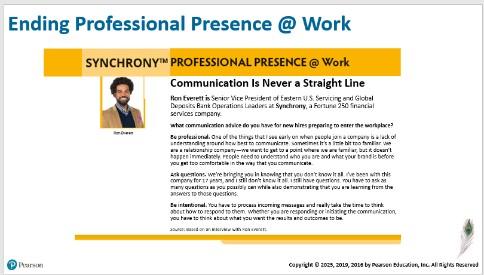


What communication advice do you have for new hires preparing to enter the workplace?
Be professional. One of the things that I see early on when people join a company is a lack of understanding around how best to communicate. Sometimes it’s a little bit too familiar. We are a relationship company—we want to get to a point where we are familiar, but it doesn’t happen immediately. People need to understand who you are and what your brand is before you get too comfortable in the way that you communicate.
Ask questions. We’re bringing you in knowing that you don’t know it all. I’ve been with this company for 17 years, and I still don’t know it all. I still have questions. You have to ask as many questions as you possibly can while also demonstrating that you are learning from the answers to those questions.
Be intentional. You have to process incoming messages and really take the time to think about how to respond to them. Whether you are responding or initiating the communication, you have to think about what you want the results and outcomes to be.
DISCUSSION STARTER: This chapter recommends that communicators address potential audience objections. Describe a communication scenario—either from your personal experience or a hypothetical business scenario —where you expect the audience might have objections. What would the objections be, and how would you address them?
NOTE: Answers will vary depending on the situations chosen. One way to frame potential objections is to base them on past objections (for example, a client who has previously raised questions about monetary costs can be expected to raise them again). Another is to extrapolate them from what is known about the audience’s goals, values, and vulnerabilities. By anticipating objections and addressing them, either by reducing fears or revealing unexpected benefits, the communicator demonstrates that they understand the audience’s needs.
REVIEW QUESTIONS, p. 30
TEACHING TIP: Encourage students to answer the review questions without copying content from the chapter. The responses below are verbatim from the chapter narrative to provide instructors with the complete content. However, students’ answers should reflect their understanding of the content in their own words.
LO 1.1 Explain why communication is a complex process that is affected by context and requires more than the delivery of messages.
1. What is professional presence?
A person’s professional presence is their ability to project competence, credibility, and confidence in their communication. (p. 4)
2. What does it mean to encode and decode a message?
To encode is to translate the intended meaning into words, images, or actions. To decode is to interpret the words, images, and actions of a message and attach meaning to them. (p. 5)
3. Identify three barriers to communication. All possible answers include technical barriers, physiological barriers, psychological barriers, semantic barriers, language barriers, and cultural barriers. (p. 5)
4. Identify three types of contexts that can influence communication. Possible answers include physical context, psychological context, social context, relational context, and cultural context. (p. 6)
LO 1.2 Identify the benefits of being an effective communicator while on the job market and throughout your career.
5. In what ways can communication skills save money or make money for a business?
Clear communication can save money by streamlining operations and increasing efficiency. Clear communication can also save money by preventing misunderstandings or reducing the need for customer support. Clear communication can also make money by reaching more customers or improving compliance. (pp. 8–9)
6. Define active listening.
Active listening involves more than just hearing what is said. Active listeners interpret what is being said and check to make sure that their interpretation is correct. Active listening also includes attention to body language and emotional cues to pick up nuances in what is being said and not said. (p. 12)
LO 1.3
Explain why it is important for communicators to be strategic, professional, and adaptable.
7. Define culture. How does it influence communication?
Culture is made up of the learned and shared attitudes, values, and behaviors that characterize a group of people. People from different cultures may have different approaches to communication, ascribe different meanings to others’ words or actions, and make very different communication choices in similar situations. Decisions that seem normal in one culture may be perceived as offensive in another. (pp. 24–25)
8. How does being concise differ from simply reducing the length of your communication? Short does not mean the same thing as concise. A message is concise when it uses no more words than necessary to achieve its purpose. If a shortened message leaves out crucial information or confuses the reader, it is not concise; it is merely short. (pp. 16–17)
9. How does business use of social media differ from personal use? Businesses use social media strategically to accomplish different goals. Businesses focus on reaching, supporting, and educating customers; recruiting employees; and strengthening employee satisfaction. (pp. 23–24)
LO 1.4 Explain how studying communication helps you develop other valuable career skills.
10. Why are collaborative skills necessary in the workplace? Most projects are too big to be accomplished by people working alone and require the coordinated effort of large teams. (pp. 25–26)
KEY CONCEPT EXERCISES
LO 1.1 Explain why communication is a complex process that is affected by context and requires more than the delivery of messages.
1 Communication is a complex process, p. 30
Think of a personal or business experience when someone “decoded” your message incorrectly and misinterpreted your meaning. Write a message to your instructor explaining the situation, the result, and how you can prevent this issue in the future.
NOTE: A good answer will explain what the original message was intended to mean, what the audience misunderstood, and why the audience misunderstood it.
2 Communication is affected by context, p. 30
Think of a personal or business situation when you tried to persuade someone with whom you have a personal or business relationship. In that situation, how did the relational context affect your credibility? In other words, was the person more or less likely to believe you based on their personal history with you? Write a message to your instructor explaining the situation, the result, and how you can prevent this issue in the future.
NOTE: Answers will vary based on students’ experiences. A good answer will indicate that the student understands the concept of relational context, can apply the concept to a communication situation, and can develop their point with detailed and relevant examples.
3 Communication requires understanding yourself and others, p. 30
Think of a personal or business situation when you had a conversation with someone that resulted in a new and shared understanding, different from what you originally intended to communicate. Write a message to your instructor explaining the situation, the result, and how you can prevent this issue in the future.
NOTE: Answers will vary based on students’ experiences. A good answer will demonstrate that the student understands the elements of the New Engagement Model of the Communication Process (see Figure 1.2 on p. 6), can use the model to explain a communication situation, and can develop their point with detailed and relevant examples.
LO 1.2 Identify the benefits of being an effective communicator while on the job market and throughout your career.
4 Effective business communicators have a competitive edge in the job market, p. 30
Use an online job bank, such as Indeed or LinkedIn, to search for job advertisements related to your career goals. How many of them include communication skills in their descriptions or requirements? Summarize your findings in a one-page message to your instructor that outlines your career goals, two or three jobs you found, and the communication skills they require.
NOTE: Answers will vary based on the job advertisements students find and their career goals.
5 Communication skills will contribute to your company’s and your own success, p. 30
Typically, when people think about business success, they think of financial success. In addition to making and saving money, what other business benefits can result from employees’ effective communication? Write a message to your instructor identifying and explaining at least two additional benefits.
NOTE: Answers will vary based on students' experiences.
6 Communication skills will contribute to your own success, p. 31
Applying your business communication skills outside of the workplace can be beneficial. Write a paragraph explaining a situation where clear and persuasive communication can help you personally.
NOTE: Answers will vary based on students' experiences.
LO
1.3 Explain why it is important for communicators to be strategic, professional, and adaptable.
7 Being strategic—Purposeful, p. 31
Read the email that follows and identify its main purpose. Rewrite the subject line and the first sentence of the email to make them clearer.
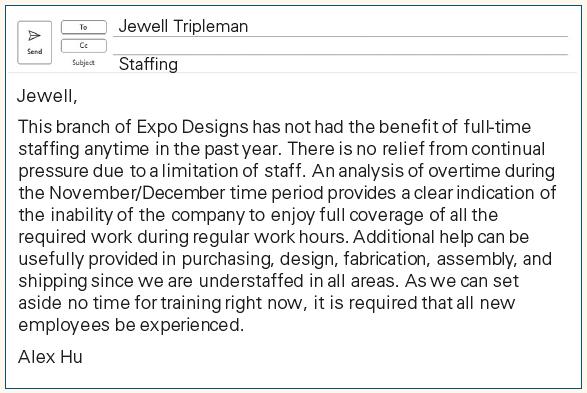

NOTE: Possible answers include that the purpose of the email is either (1) to communicate to Jewell Tripleman that the company must hire more employees, but they must be experienced, or (2) to propose a way to eliminate excess overtime costs.
The subject line might be one of these: (1) Need for Additional Experienced Employees or (2) Proposal to Eliminate Excess Overtime Costs.
The first sentence of the email might be one of these: (1) Because our overtime costs are excessive, we need to hire additional, experienced employees immediately or (2) We can reduce our overtime costs and produce better work on time if we make some strategic new hires in the next month.
8 Being strategic—Audience-oriented, p. 31
When the U.S. government’s General Services Administration (GSA) learned that a historic building site was contaminated with pigeon droppings, a staff member drafted the announcement in the next column to warn construction workers in historic buildings about the dangers of working near this potential biological hazard.
Imagine that you are asked to offer advice about revising the announcement and choosing a medium to inform workers of the hazard. After reading the announcement, write a message to your instructor recommending (1) three changes to make it easier for the audience to find the most important ideas, (2) any additional information that the message should include to address audience concerns, and (3) the medium (or combination of medium options) that you think will work best to reach the audience. Be sure to justify your recommendations.
NOTE: Answers may vary but should address all three areas specified in the prompt.

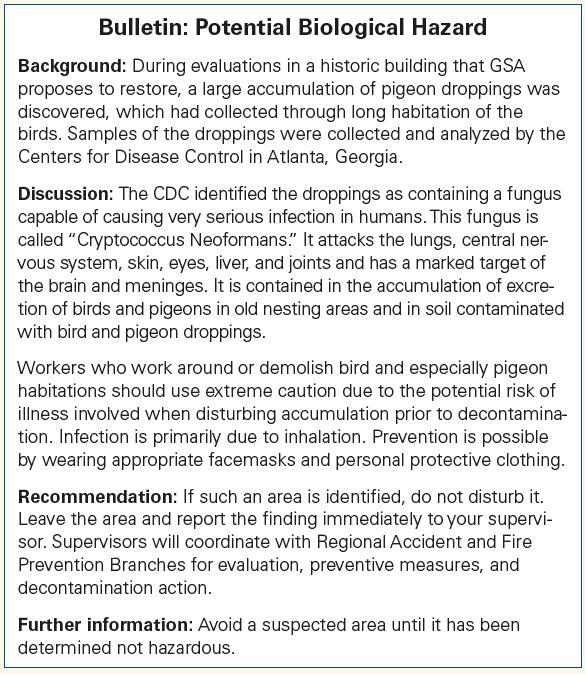
Changes to make it easier to find the important ideas could include (1) providing a more specific title that mentions pigeon droppings; (2) stating the main point of the poster at the beginning, instead of toward the end; (3) using more informative headings in the message; and (4) gathering all the instructions into one numbered list.
Additional information to provide to the workers could include (1) illustrations of recommended protective gear; (2) the name of a specific person to notify when a contaminated area has been identified; and (3) procedures for marking suspected areas.
Advantages and disadvantages of each medium could include the following. Personal meetings are timeconsuming and difficult to schedule but allow participants to ask questions and have concerns addressed immediately. Teleconferences allow remote participation from experts (e.g., CDC officials) but depend on technology. Email allows written warnings and information to be sent rapidly, but it is more difficult to verify that the message has been received and understood. Posted announcements can be effective on-site reminders but may be ignored or misconstrued. In this case, a combination of methods is probably necessary both to make sure everyone has been contacted and to allow gaps or misunderstandings to be addressed.
9 Being strategic—Persuasive, p. 31
You are the manager of a large supermarket that borders a residential neighborhood. A customer who lives nearby comes into the store and says, “I am completely out of patience with the trucks that make deliveries to your store. Deliveries start at 7 AM and end at 9 PM. Early in the morning and into the evening, trucks are banging their trailers into the loading docks. And the engines! The drivers keep the trucks running while they’re making deliveries. I can’t talk with friends in my yard because of all the noise of the trucks. And it’s not just the noise. The trucks also block the alley, so I sometimes can’t get out of my garage to get to work in the morning.”
To respond, you could just choose to explain the situation. Clear reasons exist for each of the behaviors that the neighbor is complaining about:
Local laws have set truck delivery hours from 7 AM to 9 PM. To accommodate all the deliveries, management needs to spread them throughout the day.
The engines are on in refrigerator trucks because they run the generators that keep food from spoiling.
The trucks block the alley for only a short time while they are waiting for other trucks to leave. Drivers politely move if they are asked.
However, suppose your main goal is to retain this “neighbor” as a customer and increase goodwill. In that case, you may choose to respond in a way that is more persuasive. Brainstorm content to include in your response. As you brainstorm, consider these persuasive techniques:
Show that you understand your audience’s concern.
Address the objections.
Show the benefits to the audience.
As part of your brainstorming, think of possible solutions to the problem. If you mention possible solutions, your response may be even more persuasive.
NOTE: Possible answers include: To show that you understand your audience’s concern, you can express empathy with how challenging it is to share a narrow alley with truck drivers. To address objections, you may need to concede that the trucks do make noise and occasionally block the alley. You can mention the benefit of living so close to the grocery store and having fresh food always available. As a solution to the problem, you can say that you will talk to the truck drivers and ask them not to block the alley and to turn off their engines at all times, since the refrigeration units can maintain their temperature for hours.
10 Being professional—Appropriate, p. 31
You work for HungerFighters United, a not-for-profit organization dedicated to eradicating hunger in the United States. One of your colleagues, Sheryl Greene, drafts a letter to a potential donor who has also expressed an interest in volunteering for your organization. Sheryl gives you a copy of the letter to review before sending it. You think it sounds friendly, but you wonder if Sheryl is projecting a sufficiently professional image of herself and HungerFighters. Identify at least five changes you would suggest that Sheryl make.
NOTE: Possible answers include:
(1) Begin by referencing the mutual acquaintance (Steve Cannon) rather than referencing a voicemail that the audience will probably forget by the time she gets the letter.
(2) Identify the main point of the letter early on.
(3) Focus less on introducing the writer and more on introducing the organization, Hunger Fighters.
(4) Eliminate the run-on sentence in paragraph 2.
(5) Eliminate the colloquial tone of the letter.
(6) Be more specific and gracious about hosting a party (rather than saying, “That would be an idea”).
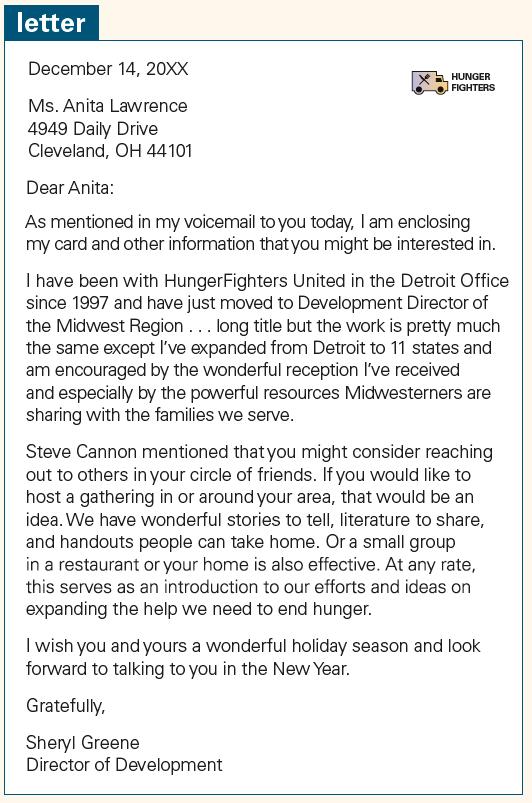
11 Being professional—Clear and concise, p. 32
Select a message you received, such as a letter from a company or an email from a colleague. Identify specific content that can be revised to be clearer and more concise. Offer specific revisions based on the content presented in the chapter.
NOTE: Answers will vary based on students’ experiences.
12 Being professional—Ethical, p. 32
Your supervisor is preparing a speech for the company’s CEO to distribute to shareholders. He asks you to read the speech and provide feedback on how effective you think it will be. As you read the speech, you think you recognize some of the points—and the wording—from a speech by a financial analyst you heard a few weeks ago on C-SPAN. You fear that parts of your supervisor’s speech are plagiarized. You wonder if you should tell him that you recognize some of that speech from another source, but you decide not to for two reasons. First, if you tell your supervisor the speech sounds familiar, he may get angry or insulted. Second, the speech was televised very late at night, so it’s unlikely that many people watched it. Evaluate the pros and cons of that choice. Is your choice ethical?
NOTE: Possible pros of not telling your supervisor: (1) You reduce the risk of angering your supervisor; and (2) by saying nothing, you avoid responsibility.
Possible cons of not telling your supervisor: (1) Your supervisor may be embarrassed later by someone else who has seen the original speech; (2) your supervisor may be sued by the person who made the original speech; and (3) you lose the opportunity to win your supervisor’s gratitude if he is copied inadvertently and was unaware of the plagiarism.
It is more ethical to tell your supervisor than to pretend you were unaware. Your supervisor may be putting his own and the company’s reputation at risk, and it is your ethical responsibility to try to prevent that from happening. However, it is not necessary to accuse your supervisor of plagiarism. Instead, you can suggest that he may want to revise his speech because it is so similar to the one on CNN that he may be accused of plagiarism.
13 Being adaptable—Current with technology, p. 32
During the COVID-19 pandemic, businesses very quickly learned to adapt to remote work and meetings, using technology such as Zoom, WebEx, Teams, and Slack. As technology companies continue to innovate and look to meet future needs, many are developing tools to support meeting in the metaverse through virtual reality (VR) or augmented reality (AR). Search the web for two companies that are developing or offering tools for AR/VR meetings. Write a message to your instructor explaining how the tools differ and which one you would prefer to use for AR/VR meetings.
NOTE: Students’ responses will vary based on the companies they find and their technology preferences.
14 Being adaptable—Current with social media, p. 32
Choose a company that interests you, and search for it on Facebook, LinkedIn, YouTube, Instagram, TikTok, and X (formerly Twitter). Based on what you find, write a message to your instructor explaining how the company uses each social media tool, whether you believe the company uses each tool effectively, and why or why not.
NOTE: Answers will vary based on the companies that students choose. Good answers will apply clear criteria for effectiveness and offer detailed examples of the companies’ uses of social media.
15 Being adaptable—Collaborative, p. 32
You are working with a team of five colleagues to research and write a report recommending a new sales strategy for your client. Because you are a very good writer, you are designated the lead writer on the project. Everyone else is writing drafts—except for one colleague, Emma Lavigne. Emma, a data analyst, has recently transferred to the United States from the Paris office, and she has had very little experience writing in English. Your team thinks Emma is contributing quite a lot to the project with her quantitative analysis, which is strong. Everyone is happy with the distribution of labor—except Emma. She transferred to the United States to improve her written English, and now she finds she isn’t being given the opportunity. Fortunately, she confides in you and tells you that she’d like to help with writing the report. How can Emma contribute in ways that will help improve her English writing but will not compromise the quality of the final product? Think of two or three ideas you can suggest to the team and to Emma.
NOTE: Possible answers include (1) writing early drafts and being an active part of the revision process; (2) performing the statistical analysis and then drafting paragraphs that analyze the statistics; and (3) providing feedback about the clarity of the report.
16 Being adaptable—Able to thrive in a diverse workplace, p. 32
Reread Exercise 15. Assume that you suggested to Emma that she write one short section of the report, which another teammate can then edit. Emma writes her part, and you provide feedback that the section is good and just needs a little editing, which you volunteer to do. Emma is happy to hear that you liked the report and that her business English is improving; however, when she sees your edits, Emma gasps. She asks you why you told her it was good when it needed so much editing. You are shocked by her response. You have never had anyone get upset with you for framing feedback positively. As you read more about French culture, you learn that the French have a reputation for being very direct in their feedback and are less concerned with softening their message. How could you handle the situation differently in the future? Would you want to adapt to Emma’s preferred form of feedback? Would you teach Emma how to understand feedback styles common in the United States?
NOTE: Possible answers include these: (1) Acknowledge how much you admire Emma for learning a new language. (2) Praise the strong elements of Emma’s work before editing it. (3) Instead of editing on your own and then showing Emma the edits, work collaboratively with her to edit the writing so she makes some of the edits herself. (4) Show Emma how heavily other people have edited your work.
LO 1.4 Explain how studying communication helps you develop other valuable career skills.
17 Analyzing skills required for jobs, p. 33
Go to the Bureau of Labor Statistics Occupational Outlook Handbook at https://www.bls.gov/ooh/. On that site, select an occupation group and then a specific occupation that interests you or that you would like to explore. For example, under the Business and Financial occupation group, you might select Market Research Analyst. Read the description of what a person in your selected occupation does and then imagine how the following career skills will be useful in that job:
Communication
Collaboration
Critical thinking
Ethical reasoning
Ability to apply knowledge in new situations
Ability to use technology effectively
Data literacy
From the list above, select three skills that you believe will be particularly important. Write a message to your instructor that briefly summarizes what the job entails and explains how the three skills you chose will help you be successful in that job.
NOTE: Answers will vary based on the specific occupations and career skills chosen. Good answers will reflect sincere interest in a given occupation, summarize key information effectively, and offer specific reasons how the skills lead to success.
SUPPLEMENTAL EXERCISES
Analyzing Your Own Experience
Think about the writing you have done in the past year, whether for school, work, or personal business. Write a list of the most significant writing experiences you have completed during that time. Select two or three experiences to develop in more detail and write what you remember about each one. Why was the outcome important to you? What was new, interesting, or difficult about the experience? What did you learn from it? What steps did you take to complete it?
Write a message to your instructor in which you briefly summarize the two or three experiences and answer the following questions:
a. How similar or different are these experiences from the writing you expect to do in your professional career?
b. If some aspect of writing was difficult in the past, how could you address that aspect in the projects you expect to work on in the future?
c. What lessons learned from past experiences do you want to apply to upcoming writing projects?
NOTE: Answers will vary based on the specific experiences cited. Good answers will provide detailed examples and explore the opportunities for experimentation and learning in a thoughtful manner.
Analyzing Communication Effectiveness
In the “Your Money” column that he writes for The New York Times, Ron Lieber shared what he calls “the single best tool I’ve ever found for getting my money back or getting my money’s worth.” When he has exhausted all other avenues of complaint (for example, talking to customer service representatives and their supervisors), he writes an Executive Email Carpet Bomb—that is, a polite but specific email that he sends to as many company executives as he can identify. The email itself contains a number of features that contribute to its success. Lieber says it has never failed him. Below is a copy of one email he sent that received good results. The names of people and the store have been replaced with XXX. Write a one or two paragraph email to your instructor, providing your analysis of the features that make this such an effective message.
Subject: Dangerous conditions and your unwillingness to fix them
Gentlemen—
I’m writing on behalf of my mother, who lives at XXX and whose townhouse backyard backs up directly against the rear wall of the XXX Supermarket. You can view the precise geography via Google Maps; my mom is in the last row of townhouses.
For years now, there have been a variety of infestations—rats, bees, etc.—related to the fact that XXX Supermarket simply will not cut down the thick tangle of vines that grow all over the rear of the store building. This year, the problem is a plague of wasps, and we have had enough of it. My mother, who is retired and on a fixed income, just spent her hard-earned retirement money on a new grill, but she cannot use it thanks to the swarm of insects out back.
Every year, she or someone from her condo association has gone to the local store management and tried to get them to cut down the vines and do something to keep them from coming back. And each year they’re met with little in the way of help. If it’s not affecting XXX Supermarket’s customers, who never see the back of the building, why should they care? That seems to be the prevailing attitude.
Someone is going to get hurt—badly—as a result of the danger that your company has created and that you have so far refused to fi x. So here is what we are asking you to do:
1) Respond via email within 24 hours to both me and my mother, who is cced, and explain what you are going to do and who the point person will be on fixing this. We’d like their cell phone number, their email address, and a promise that they will not blow off our messages.
2) Agree to send someone out to assess the situation visually within 7 days and send a crew to cut the vines once and for all within 14 days. It will take many people many days to do this, but it’s long overdue. Moreover, we want a commitment that if the vines come back, you will be out before Memorial Day each year to cut them down again.
[Name of CEO], with one pointed phone call to the right person, you especially could make this problem go away very quickly. Please imagine that this was your own mother when you consider how best to handle this.
Thanks to all of you for your prompt consideration of this matter.
Yours, Ron
Lieber
NOTE: Students may consider this communication to be effective because it (1) offers clear reasons why the vines at the back of the building cause inconvenience to the store’s neighbors, (2) is clearly structured and easy to follow, (3) uses a tone that is vivid, emphatic, and personal, and (4) specifies very clearly what actions must be taken to address the issue within a specific timeframe. Students may also comment on the appeals to the readers’ feelings through highlighting the plight of the writer’s retired mother. However, some students may argue that the letter is excessive or inappropriate, either because its tone borders on sarcasm or because its appeals to feelings could be dismissed as manipulative.
Planning a Virtual Team Meeting
Imagine that you are working on a team with members in the United States, Singapore, and the Netherlands. You need to check in with each other at least once a week to address issues and plan for the upcoming week. This requires that you decide on a technology for your weekly discussions. You are considering the following options:
• Wiki
• Internet chat
• Teleconferences (for example, using Skype)
• Videoconferences (for example, using WebEx)
Use your favorite search engine to learn more about these technologies. If you have five members in your team, assign one technology to each team member. Then collaborate to create a chart that analyzes the pros and cons of each option. As a team, determine which technology (or technologies) you would choose and explain why. Be prepared to discuss your chart in class or submit it according to your instructor’s directions.
NOTE: Each group member should research and outline the pros and cons of their assigned technology option. The team as a whole should select one technology that they believe is best for the scenario and construct a clear and persuasive argument.
Increasing Cultural Sensitivity
Divide into teams of three to five students—or work as a whole class. Select at least three cultures not represented by anyone on your team. When you identify cultures, do not limit yourself to thinking about different countries of origin. Also, consider the following variables:
• Region of the country (for example, the South or the Northeast in the United States)
• Ethnicity
• Age (for example, people in their teens, 20s, 30s, 40s, and so on)
• Gender
• Disability
For each of the cultures you have identified, list two or three “communication characteristics”—things to keep in mind when communicating with people of that culture. Illustrate each with a concrete example. Prepare a class presentation of your findings. If the findings of different teams conflict, have a class discussion about why the teams drew different conclusions about a particular culture.
NOTE: Presentation content will vary.
Analyzing Online Privacy Policies
Work with two to four other students to obtain online privacy policies from three organizations, which can include businesses, government agencies, or not-for-profit organizations. Working individually, read the policies carefully, paying special attention to the parts of each policy that discuss how the end user’s personal information will or will not be used. Select two or three sentences from each policy that you think are not clear. Working as a team, compare and contrast the individual examples. Identify what the examples have in common and discuss as a group how they could mislead readers. Summarize your findings for your instructor in a collaboratively drafted email.
NOTE: Answers will vary depending on the organizations chosen. Instructors may wish to provide sample privacy policies that they consider to be good or bad examples. Passages that are good targets for comparison and contrast will be both concise and detailed. Good emails will list specific similarities and differences, and state the team’s findings clearly.
Analyzing Business Facebook Pages
Imagine that you work for a local restaurant in a small city. The owner of the restaurant would like to begin using social media—especially a Facebook page—to publicize the restaurant and attract customers. She has asked you to find two restaurant Facebook pages that you believe are effective and to summarize the key features you believe make the pages effective. Depending on your instructor’s preferences, write a brief report or prepare a brief presentation analyzing the two pages.
NOTE: Good report and presentation content will explain how the examples are effective in advancing the goals of the restaurants.
Identifying How For-Profit and Not-For-Profit Organizations Use X (formerly Twitter)
Go to X (formerly Twitter) and search for one for-profit company you like and one not-for-profit organization whose cause you support. Both must have X (formerly Twitter) accounts. Select at least three tweets produced by each organization. Identify the purpose of each tweet and then write a brief summary (fewer than 100 words) analyzing how each organization uses X (formerly Twitter) to communicate.
NOTE: Good analyses will identify at least three tweets, and from those tweets will draw inferences about the organizations’ communication goals.
SPEAKING ACTIVITIES
Informal Impromptu Presentations
a. Describe a time when you were very successful at achieving a specific communication goal, such as persuading someone to do something. Identify at least one reason for your success.
b. Describe a time when you wanted to achieve a specific goal with communication but were unsuccessful. Identify at least one reason why you were not successful.
c. Based on your experience, give your classmates one or two tips for collaborating successfully with a teammate.
d. Do you think you are better at writing or speaking? Provide examples to support your answer.
e. Think of a time when you communicated with people from a different culture. What was your biggest challenge?
NOTE: Answers will vary based on students’ experiences. To help students develop good presentation skills, encourage them to begin their impromptu presentations with a main idea and then develop that idea in two or three minutes.
Executive Briefings
a. Are they thinking like business communicators? Find an “official email” that you have received from an organization you do business with—for example, from a retail store, your school, employer, bank, or insurance company. Analyze the message to determine whether the writers were thinking like effective business communicators, as described in this chapter. Identify two features of the email that you can discuss; both features can be effective, both can be ineffective, or you can discuss one example of each.
b. Analyzing cultures. Select a country that you have visited or would like to visit in the future and conduct a web or library search about communication in that country. (Be sure your sources are authoritative. Do not use Wikipedia.) Make two or three recommendations about communication for colleagues who will be traveling to that country.
c. Analyzing professionalism. Imagine that you are a small business owner and need to purchase a product or service (for example, executive coaching). Find two competitive websites that offer what you’ve chosen. Imagine that you are going to choose a vendor based on the professionalism of the website. Prepare a brief presentation about which site inspires more confidence and explain why.
NOTE: Assign students one of the topics listed and give them a day or two to prepare their executive briefing, which should be a short (three to five minute) presentation in front of the class. Visuals may be useful, depending on the topic. Encourage the class to identify both the strengths and weaknesses of the presentations in a supportive manner that develops improved speaking skills.
GENERATIVE ARTIFICIAL INTELLIGENCE ACTIVITY
LO 1.1 Explain why communication is a complex process that is affected by context and requires more than the delivery of messages.
LO 1.2 Identify the benefits of being an effective communicator while on the job market and throughout your career.
LO 1.3 Explain why it is important for communicators to be strategic, professional, and adaptable.
LO 1.4 Explain how studying communication helps you develop other valuable career skills.
Use a Gen/AI tool of your choice and enter one of the four learning objectives (or a specific one as assigned by your instructor) for this chapter. Read the answer the tool provides. Make a list of the information that is consistent with the content in this chapter. Make another list that identifies content that is not included in this chapter. Then enter the same learning objective in a different Gen/AI tool. Compare the result with the first tool’s answer. What content is similar between the two, and what is different? Summarize your findings in a short report to your instructor; include your lists as appendices to the report.
NOTE: Answers will vary based on which learning objective students choose and which Gen/AI tools they use. When evaluating their work, compare their lists to the at-a-glance heading outline.
